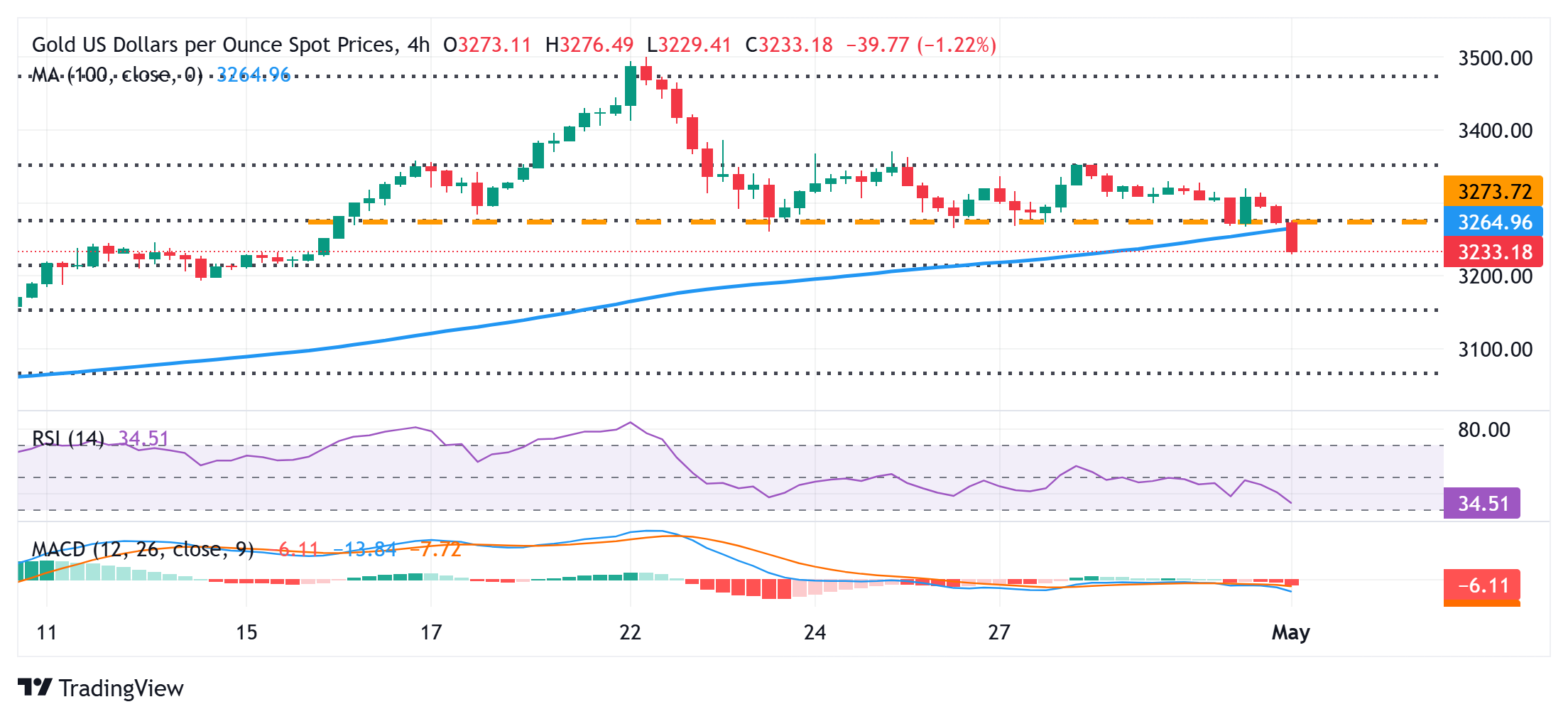Created
: 2025.05.01














![]() 2025.05.01 12:57
2025.05.01 12:57
Gold price (XAU/USD) remains under some selling pressure for the third successive day and drops to a two-week low, around the $3,230-$3,229 area during the Asian session on Thursday. US President Donald Trump's remarks earlier today add to the recent optimism over the potential de-escalation of the US-China trade war and turn out to be a key factor driving flows away from the safe-haven precious metal. Furthermore, the US Dollar (USD) is looking to build on its gains registered over the past two days and exert additional downward pressure on the commodity.
The intraday downfall in the Gold price could further be attributed to some technical selling following a breakdown below the $3,265-3,260 pivotal support. Any meaningful USD appreciation, however, seems elusive amid rising bets for more aggressive policy easing by the Federal Reserve (Fed), bolstered by the surprise contraction in US GDP and signs of easing inflationary pressure. This could act as a tailwind for the non-yielding yellow metal, warranting caution before positioning for an extension of the retracement slide from the $3,500 mark, or the all-time peak.

From a technical perspective, acceptance below the 38.2% Fibonacci retracement level of the latest leg up from the vicinity of mid-$2,900s or the monthly swing low, and a breakdown below the $3,265-$3,260 could be seen as a key trigger for bears. That said, oscillators on the daily chart - though they have been losing positive traction - are yet to confirm the negative outlook. Hence, it will be prudent to wait for some follow-through selling below the 50% Fibo. level, around the $3,229-$3,228 region, before positioning for further losses. The Gold price might then accelerate the decline toward the $3,200 round figure en route to the 61.8% Fibo. level, around the $3,160 zone.
On the flip side, any attempted recovery might now confront resistance near the aforementioned support breakpoint, around the $3,260-$3,265 region. This is followed by the 38.2% Fibo. level, just ahead of the $3,300 mark, which if cleared might trigger a short-covering rally and lift the Gold price to the $3,348-$3,350 supply zone. Some follow-through buying, leading to a subsequent strength beyond the $3,367-$3,368 region (23.6% Fibo. level), will suggest that the recent corrective pullback has run its course. The XAU/USD pair might then aim to reclaim the $3,400 mark and extend the momentum further toward the $3,425-3,427 intermediate hurdle before attempting to conquer the $3,500 psychological mark.
Generally speaking, a trade war is an economic conflict between two or more countries due to extreme protectionism on one end. It implies the creation of trade barriers, such as tariffs, which result in counter-barriers, escalating import costs, and hence the cost of living.
An economic conflict between the United States (US) and China began early in 2018, when President Donald Trump set trade barriers on China, claiming unfair commercial practices and intellectual property theft from the Asian giant. China took retaliatory action, imposing tariffs on multiple US goods, such as automobiles and soybeans. Tensions escalated until the two countries signed the US-China Phase One trade deal in January 2020. The agreement required structural reforms and other changes to China's economic and trade regime and pretended to restore stability and trust between the two nations. However, the Coronavirus pandemic took the focus out of the conflict. Yet, it is worth mentioning that President Joe Biden, who took office after Trump, kept tariffs in place and even added some additional levies.
The return of Donald Trump to the White House as the 47th US President has sparked a fresh wave of tensions between the two countries. During the 2024 election campaign, Trump pledged to impose 60% tariffs on China once he returned to office, which he did on January 20, 2025. With Trump back, the US-China trade war is meant to resume where it was left, with tit-for-tat policies affecting the global economic landscape amid disruptions in global supply chains, resulting in a reduction in spending, particularly investment, and directly feeding into the Consumer Price Index inflation.
![]()
Created
: 2025.05.01
![]()
Last updated
: 2025.05.01

FXStreet is a forex information website, delivering market analysis and news articles 24/7.
It features a number of articles contributed by well-known analysts, in addition to the ones by its editorial team.
Founded in 2000 by Francesc Riverola, a Spanish economist, it has grown to become a world-renowned information website.
We hope you find this article useful. Any comments or suggestions will be greatly appreciated.
We are also looking for writers with extensive experience in forex and crypto to join us.
please contact us at [email protected].
Disclaimer:
All information and content provided on this website is provided for informational purposes only and is not intended to solicit any investment. Although all efforts are made in order to ensure that the information is correct, no guarantee is provided for the accuracy of any content on this website. Any decision made shall be the responsibility of the investor and Myforex does not take any responsibility whatsoever regarding the use of any information provided herein.
The content provided on this website belongs to Myforex and, where stated, the relevant licensors. All rights are reserved by Myforex and the relevant licensors, and no content of this website, whether in full or in part, shall be copied or displayed elsewhere without the explicit written permission of the relevant copyright holder. If you wish to use any part of the content provided on this website, please ensure that you contact Myforex.
Myforex uses cookies to improve the convenience and functionality of this website. This website may include cookies not only by us but also by third parties (advertisers, log analysts, etc.) for the purpose of tracking the activities of users. Cookie policy